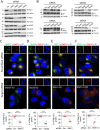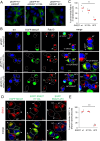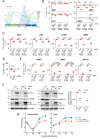SNX27:Retromer:ESCPE-1-mediated early endosomal tubulation impacts cytomegalovirus replication
- PMID: 39359939
- PMCID: PMC11445146
- DOI: 10.3389/fcimb.2024.1399761
SNX27:Retromer:ESCPE-1-mediated early endosomal tubulation impacts cytomegalovirus replication
Abstract
Introduction: Cytomegaloviruses (CMVs) extensively reorganize the membrane system of the cell and establish a new structure as large as the cell nucleus called the assembly compartment (AC). Our previous studies on murine CMV (MCMV)-infected fibroblasts indicated that the inner part of the AC contains rearranged early endosomes, recycling endosomes, endosomal recycling compartments and trans-Golgi membrane structures that are extensively tubulated, including the expansion and retention of tubular Rab10 elements. An essential process that initiates Rab10-associated tubulation is cargo sorting and retrieval mediated by SNX27, Retromer, and ESCPE-1 (endosomal SNX-BAR sorting complex for promoting exit 1) complexes.
Objective: The aim of this study was to investigate the role of SNX27:Retromer:ESCPE-1 complexes in the biogenesis of pre-AC in MCMV-infected cells and subsequently their role in secondary envelopment and release of infectious virions.
Results: Here we show that SNX27:Retromer:ESCPE1-mediated tubulation is essential for the establishment of a Rab10-decorated subset of membranes within the pre-AC, a function that requires an intact F3 subdomain of the SNX27 FERM domain. Suppression of SNX27-mediated functions resulted in an almost tenfold decrease in the release of infectious virions. However, these effects cannot be directly linked to the contribution of SNX27:Retromer:ESCPE-1-dependent tubulation to the secondary envelopment, as suppression of these components, including the F3-FERM domain, led to a decrease in MCMV protein expression and inhibited the progression of the replication cycle.
Conclusion: This study demonstrates a novel and important function of membrane tubulation within the pre-AC associated with the control of viral protein expression.
Keywords: Cytomegalovirus; ESCPE-1; assembly compartment; beta-herpesvirus secondary envelopment; retromer; sorting nexin 27; tubular endosomes.
Copyright © 2024 Štimac, Marcelić, Radić, Viduka, Blagojević Zagorac, Lukanović Jurić, Rožmanić, Messerle, Brizić, Lučin and Mahmutefendić Lučin.
Conflict of interest statement
The authors declare that the research was conducted in the absence of any commercial or financial relationships that could be construed as a potential conflict of interest. The author(s) declared that they were an editorial board member of Frontiers, at the time of submission. This had no impact on the peer review process and the final decision.
Figures






References
-
- Birzer A., Kraner M. E., Heilingloh C. S., Mühl-Zürbes P., Hofmann J., Steinkasserer A., et al. . (2020). Mass spectrometric characterization of HSV-1 L-particles from human dendritic cells and BHK21 cells and analysis of their functional role. Front. Microbiol. 11. doi: 10.3389/fmicb.2020.01997 - DOI - PMC - PubMed
MeSH terms
Substances
LinkOut - more resources
Full Text Sources
Miscellaneous

